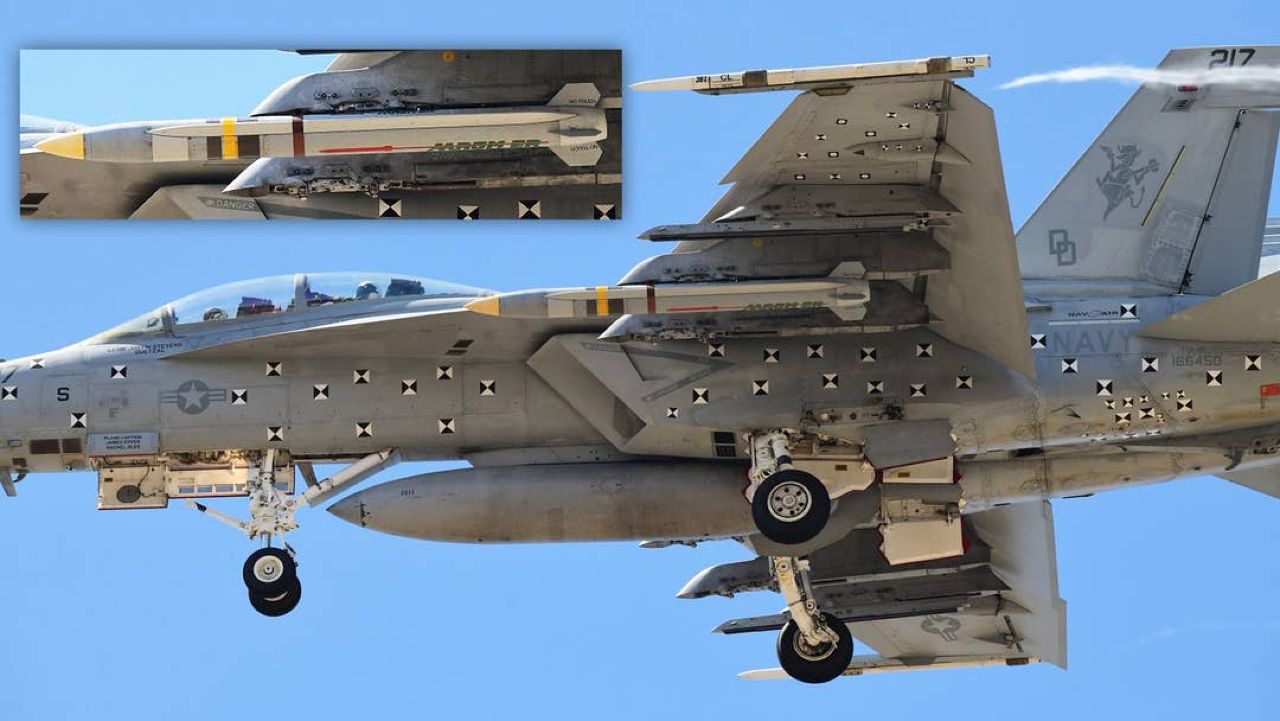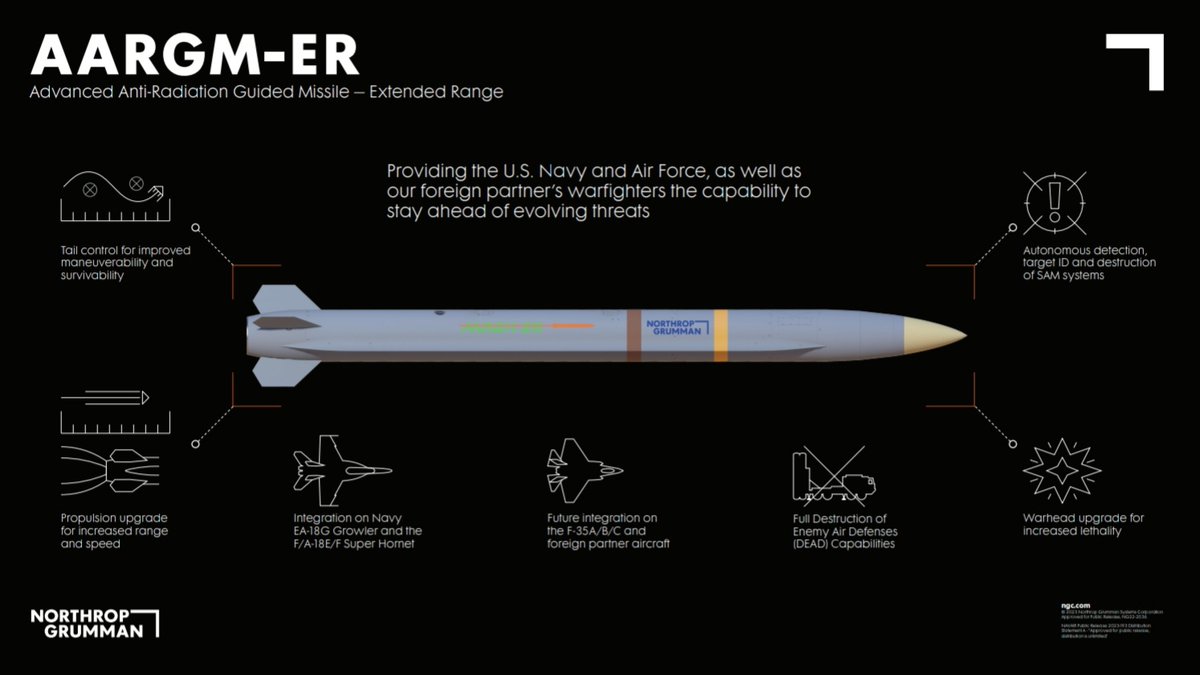The Pentagon has reportedly signed an agreement with Lockheed Martin to integrate AGM-88G High-Speed Anti-Radiation Missiles (HARMs) on all the fifth-generation F-35 Lightning II stealth aircraft variants.
Lockheed was awarded a contract by the Pentagon on January 12, valued at over US$97 million, to finance the initial development work for the integration of the fifth-generation F-35 with the Northrop Grumman AGM-88G Advanced Anti-Radiation Guided Missile – Extended Range (AARGM-ER), according to several media reports.
Initially developed by Raytheon and first deployed by the US Air Force in 1984, the AGM-88 High-Speed Anti-Radiation Missile (HARM) has essentially served as the foundation for Northrop’s AARGM and AARGM-ER. Northrop Grumman, which manufactures the missile, and the Pentagon have been hinting at the said integration for a while now.
There is also an AGM-88E Advanced Anti-Radiation Guided Missile in service, a previous, shorter-range version of the Northrop-made missile. However, the AGM-88G is the latest anti-radiation missile in the US arsenal. It is a precision-guided weapon intended to identify and destroy air defense radars by their electromagnetic radiation emissions.
The latest agreement with Lockheed will cover AGM-88G integration for all three F-35 types operated by the United States and F-35 and AARGM-ER foreign military sales customers. The contract announcement refers to the US Air Force (USAF), US Navy (USN), US Marine Corps, Australia, Canada, the UK, Norway, Italy, the Netherlands, and Denmark.
🇺🇸 @LockheedMartin was awarded a modification contract by the 🇺🇸 @usairforce to provide for the early development of the @northropgrumman AGM-88G AARGM-ER missile integration on the @LockheedMartin F-35A/B/C Lightning II fighter jet. pic.twitter.com/dwiSJFDVRF
— Defence 360° (@Defence360) January 13, 2024
According to senior USAF officers, in any contemporary, high-intensity conflict, especially with near-peer adversaries like China, the capacity to destroy the enemy’s air defense equipment will be essential. The AARGM and AARGM-ER are believed to be crucial assets in such a future conflict.
Beginning in 2021, the US Navy has attempted to integrate the AARGM-ER with its carrier-based aircraft, the Boeing F/A-18 Super Hornet and the EA-18G Growler. There have been several successful test fires towards that effort.
The F-35 is considered one of the best strike fighter aircraft in the US military, but it isn’t equipped to carry and use the best weapons for that purpose. The US military has consistently maintained that they would be integrated on F-35A of the Air Force, F-35B of the Marine Corps, and F-35C of the US Navy.
Lockheed F-16 are capable of carrying anti-radiation missiles like the AGM-88 HARM. However, non-stealth aircraft missions against contemporary air defenses are considered relatively dangerous. This likely serves as a motivation to equip F-35s with the advanced variants of these missiles, given their higher chances of survivability.
Though the USAF and Northrop have a contract to develop a brand-new air-to-surface missile called the Stand-in Attack Weapon, the Pentagon anticipates that the project will require a minimum of three years. By certifying the current AARGM-ER with the F-35A, allied air and naval forces will have more options for suppressing enemy air defense missions.
Moreover, the latest announcement of an agreement with Lockheed comes just months after it was announced in late November 2023 that the US Air Force and the US Navy would acquire 118 of the advanced AGM-88G Advanced Anti-Radiation Guided Missiles – Extended Range (AARGM-ER). For this, Naval Air Systems Command officials announced a US$235.7 million contract last month.
AARGM Extended Range Missile
The AGM-88G Advanced Anti-Radiation Guided Missile-Extended Range (AARGM-ER) is an air-launched missile that can quickly combat air defense threats. To extend range, the AARGM-ER configuration uses earlier investments made in the AGM-88E AARGM by adding a new solid rocket motor.
The AARGM-ER, whose development started in 2016, combines hardware and software upgrades to enhance the AGM-88E AARGM’s current capabilities, which include increased range, durability, and efficacy against potential threats.
The USN’s AARGM-ER conducted its fifth consecutive successful flight test, which was disclosed in May of this year by Northrop Grumman Corporation. An advanced, land-based emitter target was said to have been successfully detected, identified, located, and engaged by the missile.

The missile has a sophisticated digital anti-radiation homing sensor, a millimeter wave radar terminal seeker, net-centric connectivity, guidance from the inertial navigation system, GPS, and weapon-impact-assessment (WIA) transmission.
According to a previous US military document, the Pentagon has plans to ensure that the AARGM-ER is integrated into the F/A-18E/F Super Hornet and EA-18G Growler aircraft and configured for internal carriage on the F-35 Lightning II.
In comparison to the HARM systems it replaces, the missile has better capabilities: enhanced detection range, enhanced frequency coverage, enhanced field of view, enhanced counter-emitter shutdown via active millimeter wave radar terminal guidance, time-critical standoff strike, missile-impact zone control to prevent collateral damage, and bomb damage assessment.

Using the AGM-88E’s guidance system and warhead, the AGM-88G AARGM-ER doubles the AGM-88E’s range with a solid integrated rocket-ramjet engine. It features an entirely new control section with an internal carriage and an 11.5-inch rocket motor providing twice the range of the Lockheed Martin F-35A and F-35C Lightning II Joint Strike Fighter.
With a new airframe that replaces the mid-body wings with aerodynamic strakes along the sides, control surfaces moved to low-drag tail surfaces, and a more potent propulsion system for increased speed and double the range of its predecessor, the AGM-88G combines the warhead and guidance systems of the AGM-88E.
The AGM-88G, for one, is 13.3 feet long and weighs 1,030 pounds. AARGM-ER development uses digital modeling and integrated advanced AARGM sensors and electronics in a new high-performance air vehicle with upgraded propulsion and an optimized warhead.
With an additional active millimeter wave seeker, the AARGM-ER can defeat radar shutdown and passive radar thanks to updated software and enhanced capabilities. It was possible to spoof earlier iterations of the missile by disabling radar before the weapon detected their signals.
In recent years, the US military has made an effort to modernize its arsenals and aircraft to combat more sophisticated adversaries like China in contested environments, as opposed to the two decades of Middle East conflict that mostly took place in uncontested airspace. Integrating AARGM-ER on the F-35 fighters is another sincere attempt in that direction.
The AARGM mission is to suppress and destroy enemy air defenses (SEAD/DEAD). Its primary targets are re-locatable integrated air defense targets and targets that utilize shutdown tactics, which are neutralized through a multi-mode seeker.
- Contact the author at sakshi.tiwari9555 (at) gmail.com
- Follow EurAsian Times on Google News




